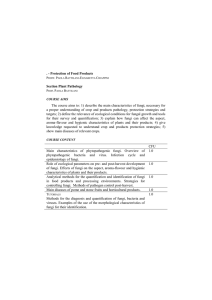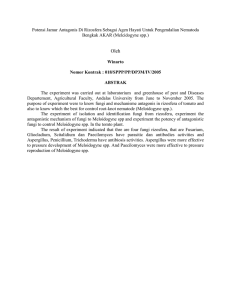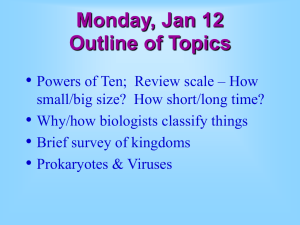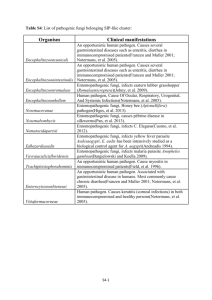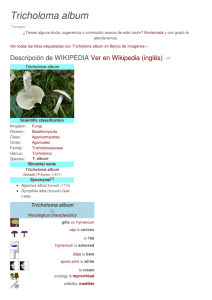Fungi General Characteristics Great diversity
advertisement
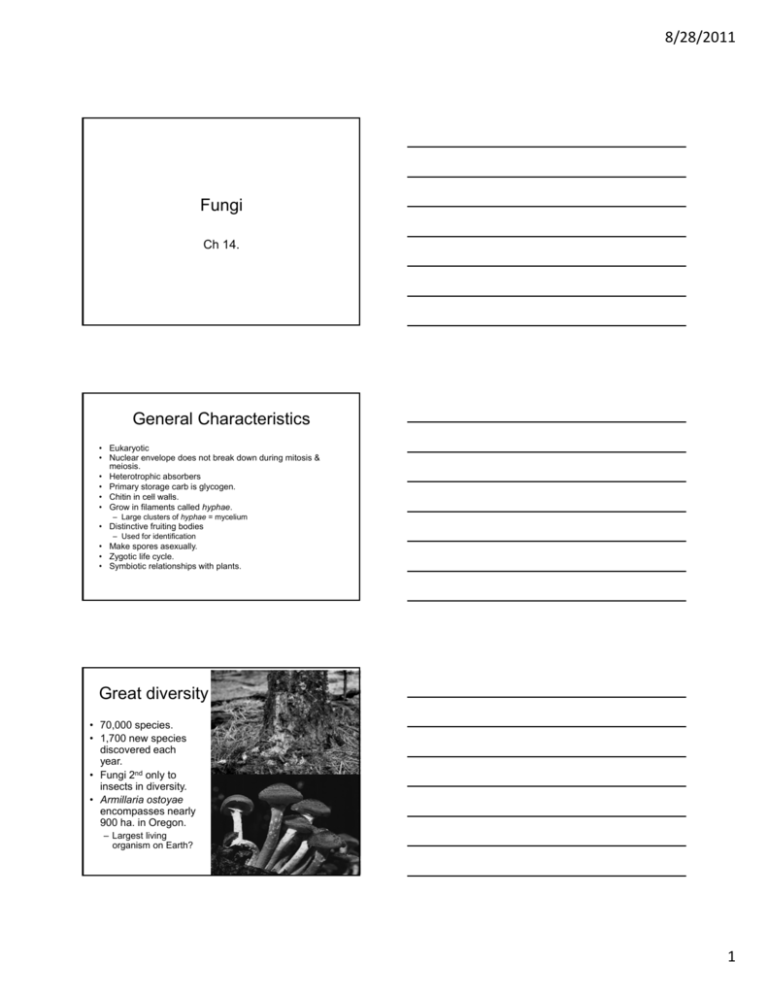
8/28/2011 Fungi Ch 14. General Characteristics • Eukaryotic • Nuclear envelope does not break down during mitosis & meiosis. • Heterotrophic absorbers • Primary storage carb is glycogen. • Chitin in cell walls walls. • Grow in filaments called hyphae. – Large clusters of hyphae = mycelium • Distinctive fruiting bodies – Used for identification • Make spores asexually. • Zygotic life cycle. • Symbiotic relationships with plants. Great diversity • 70,000 species. • 1,700 new species discovered each year. • Fungi F i 2ndd only l tto insects in diversity. • Armillaria ostoyae encompasses nearly 900 ha. in Oregon. – Largest living organism on Earth? 1 8/28/2011 Importance of Fungi • Ecologically important – Function as decomposers • Medical & economical importance as: – Pests, P t pathogens, th & producers d off certain t i chemicals. • Form symbiotic relationships – Mainly in plant roots. Fungi as decomposers • Principle decomposers in the biosphere. • Releases CO2, returns N to soil. • Top 20cm of fertile soil – 5 metric tons of f fungi i&b bacteria. t i • Attack foodstuffs, decreasing palatability – Toxic substances known as mycotoxins. Fungi as pathogens • Most important causal agent of plant diseases. • Most common in tropical regions. • 40% off hospital h it l deaths d th iin 80’ 80’s d due tto fungi. Chytrid Red Fungus Rhizopus 2 8/28/2011 Beneficial fungi Saccharomyces cerevisiae Penicillium roquefortii Conidia of the fungus (spores) Fungi as symbionts • 80% of plants form mutualisms – Mycorrhizae (between roots & fungi) 3 8/28/2011 Types of mycorrhizae • Ectomycorrhizal – Usually a gymnosperm (pines) • Endomycorrhizal E d hi l – Usually orchids & ericoids (rhododendrons) – Also, citrus, coffee, & rubber Fungi Phyla A closer look!!!!! Four major phyla of fungi • Chytridiomycota – Chytrids • Zygomycota – Zygomycetes • Ascomycota – Ascomycetes • Basidiomycota – Classes Basidiomycetes, Teliomycetes, & Ustomycetes 4 8/28/2011 Major Characteristics of Fungal Phyla 14-1 Hyphae • Hyphae – fungal filaments • Mycelium – mass of hyphae – Individual fungus may produce > 1 km of new hyphae within 24 hrs. hrs • Septa – divide hyphae (crosswalls) • Such hyphae are called ‘septate’. • Hyphae lacking septa are called ‘aseptate or coenocytic’. 5 8/28/2011 Heterotrophic absorbers • Absorb b/c cell walls are rigid. • Occurs near growing tips of hyphae. • Function as: – Saprophytes (living on organic materials) have rhizoids. – Parasites - haustoria – Mutualists Mitosis & Meiosis • Nuclear envelope does not disintegrate & re-form. • Form spindle pole bodies – SPB’s SPB’ and d centrioles t i l ffunction ti as microtubule i t b l organizing centers during mitosis & meiosis. 6 8/28/2011 Reproduction • Both sexual & asexual • Asexual – Spores • Spo Sporangia a ga o or co conidiogenous d oge ous ce cells s • Sexual – 3 phases • Plasmogamy (fusion of protoplasts) • Karyogamy (fusion of nuclei) • Meiosis The Chytrids: Chytridiomycota • Predominantly aquatic (790 spp.) • Chitin • Store glycogen • Coenocytic • Motile cells (zoospores & gametes) • Infect a number of hosts Batrachochytrium dendrobatidis (Bd) © Forrest Brem 7 8/28/2011 Allomyces arbusculus –Alteration of isomorphic generations Bd life cycle Zygomycetes: Zygomycota • Mostly parasites & mutualist (~ 1060 spp.) • Coenocytic hyphae • Usually have profuse, rapidly growing h h hyphae: – Hyphae called ‘stolons’ form rhizoids • Named for sexually produced ‘zygospores’. • Form endomycorrhizal associations 8 8/28/2011 Rhizopus stolonifer Gametangia – fusing to produce zygospore Zygospore developing within zygosporangium Ascomycetes: Ascomycota • Blue-green, red, and brown molds (~32,00 spp.) • Unicellular or filamentous growth p of modified hyphae yp • Conidia borne at tips called “conidiophores”. • Asexual spores are produced externally as conidia. • Sexual reproduction involves the formation of an ascus which ascospores are produced. 9 8/28/2011 Two asci Ascoma Ascoma 10 8/28/2011 • Asci develop on inner surface of ascoma called hymenium. • Antheridia “male gametangia” • Ascogonia “female gametangia” Basidiomycetes, Teliomycetes, & Ustomycetes: Basidiomycota • Most familiar fungi (~ 22,000 spp.) • Mushrooms, toadstools, puffballs, shelf fungi. • Produce P d b idi basidiospores b borne outside t id clubl b shaped basidium. 11 8/28/2011 Class Basidiomycetes • Includes Hymenomycetes & Gasteromycetes. • Edible & poisonous mushrooms, coral fungi, tooth fungi, and shelf & bracket fungi. • Referred R f d as hymenomycetes h t because b basidiospores are produced on the hymenium. • Gasteromycetes have no distinct hymenium is visible. – False puffballs, bird’s nest fungi, and puffballs. Hymenomycetes • Toadstools usually recognized – Pileus (cap) – Stipe (stalk) – Gills 12 8/28/2011 Mycelium spreads and dies in center Gasteromycetes • Form peridium (outer covering) – Opens naturally, spores not expelled • Some cases spores need to be liberated by g etc…)) external source ((i.e., animal or tree falling Puffballs Netted Stinkhorn 13 8/28/2011 Teliomycetes • Referred to as rusts – Billions of dollars in crop damage • Heteroecious – Two hosts to complete life cycle • Autoecious – One host 14 8/28/2011 15 8/28/2011 Ustomycetes • Parasites to flowering plants – a.k.a smuts • Autoecious Yeasts • Unicellular fungus • Saccharomyces cerevisiae Conidial Fungi • a.k.a Anamorphs • Medically important – Penicillium (penicillin-producing fungi) – Aspergillus A ill (respiratory ( i t di diseases)) 16 8/28/2011 Symbiotic relationships • Mutualisms or parasitisms • Lichens – Mycobiont + Photobiont • 98% b belong l tto A Ascomycota t • Remaining belong to Basidiomycota Mycorrhizae • “Fungus roots” • Endomycorrhizae – Penetrate root cells – Often Oft called ll d “V “Vesicular-arbuscular” i l b l ” mycorrhizae • Ectomycorrhizae – Surround root cells 17 8/28/2011 Endomycorrhizae Ectomycorrhizae Summary • • • • • • • • • • • • • Ecologically & Economically important Most composed of hyphae Absorb & produce spores 4 distinct phyla Chytrids form flagellated, motile cells. Zygomycota form zygospores in zygosporangia. zygosporangia Ascomycota form ascospores internally in asci. Basidiomycota form basidiospores externally on basidia. Mushrooms, rusts, & smuts represent 3 classes of Basidiomycota. Yeasts are unicellular. Fungi with no sexual state are Conidial Fungi. Lichens = Mycobionts + Photobionts Mycorrhizae = mutualistic associations between Fungi & Roots. 18

